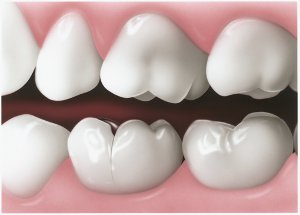Dental Crown Pain: Reasons Your Crown is Causing Toothaches and What to Do


Image courtesy of Pexels.
Dental crowns are a great option to cover and protect a damaged tooth. They provide you with a tooth replacement that looks and acts like your natural tooth, allowing you to eat your favorite foods and keep your smile looking great.
But what happens when you start to experience pain or sensitivity in the area where your crown was placed?
Many people think that because they have a dental crown, they no longer have to worry about tooth pain. Unfortunately, that belief is not true. A tooth with a crown can still experience infection, cavities and other common dental concerns.
When a toothache occurs, knowing what could be wrong and what to do about it can make all the difference. And the sooner you react to the problem and get an appointment scheduled with your dental provider, the better.
In this article, we’ll look at a few different reasons why you may be experiencing dental crown pain and what to do about it.
Here’s a quick look at the main topics that will be covered:

A dental crown is a cover or “cap” that is placed over a tooth. A crown helps to restore a damaged or missing tooth to its normal shape, size and function. Dental crowns are used when fillings are not enough to solve the problem and will help protect the tooth and improve the way it looks.
When placing a crown, your dentist will remove the outer portion of the tooth and eliminate any decay present. Then, once the area is cleaned correctly, your dentist will place a temporary crown in place of the missing tooth while the permanent crown is being made.
Once the permanent crown is ready, they will verify the fit, seal, color, flossing contact, and bite are correct. At this point, you will have a permanent solution that will function and look like your natural teeth.
Dental crowns can be made of a variety of different materials, including stainless steel, metal, porcelain-fused-to-metal, resins, or ceramic. Your dentist can help you determine which material is best for your specific needs.
There are a variety of reasons why your dentist may recommend having a crown placed. Some common reasons why you may need a dental crown include:
Crowns are a common solution used by dentists to replace broken teeth and provide the patient with a more natural solution. Once a crown is placed, you go about your life the same as you did before.
Even though dental crowns are a commonly used solution, there are some instances where you may experience toothaches or pain. To address these toothaches, you may need additional adjustments due to the way your bite functions.
It’s essential to speak with your dentist about any problems you’re experiencing — especially if it’s something that is a recurring problem. Your dentist can then take a look and determine what the best solution is for you.
Here are a few of the most common reasons why you may be experiencing dental crown pains.
If you’ve just recently had your new crown placed, the pain or discomfort you’re feeling may simply be due to the procedure itself. This pain is usually associated with temperature sensitivity or discomfort when applying pressure biting.
Any pain you experience after a crown is placed should start to dissipate over time. Each day should be better than the last and you likely won’t feel discomfort that lasts longer than two weeks.
This type of pain should not be excruciating or keep you from doing things that are part of your daily routine, like eating, talking or sleeping. If you’re experiencing high levels of pain lasting longer than two weeks, you’ll want to speak with your dentist and schedule an appointment to identify the cause of the problem.
There are some issues that you want to address right away, such as if your tooth feels like it is the first tooth that hits when you bite down. A simple adjustment to the biting surface of the tooth will help to relieve that pressure.
In many cases, a crown is placed on a tooth that does not require a root canal. In this scenario, the tooth still has nerves in it, and when a crown is placed on top of the remaining tooth, the nerve can still develop an infection or worsening sensitivity that could result in needing root canal therapy.
It’s also possible that an infection could occur due to old fillings that live below the crown that are leaking bacteria.
This bacteria can then infect the nerve and cause you to have a painful toothache. This is why most dentists will remove previous fillings and perform what is called a core build-up to ensure that all decay and cracks have been addressed.
Signs that you may have an infection include:
If you are experiencing pain from an infection, your dentist will likely need to perform a root canal to remove the remaining nerves below the crown. This will allow your dentist to treat the infection and clear the root canal to avoid decreasing the chances of future infections.
Even after placing a crown, it’s still possible to have continued tooth decay or cavities. A cavity can form at the border of the tooth and the crown, causing you pain in the process.
Cavities and tooth decay under a crown can lead to continuous pain and can cause damage to the nerves under the tooth.
If your toothache is due to a new cavity or tooth decay, this is another scenario where a root canal may be the best permanent solution. Telling your dentist about your symptoms and having a thorough check-up is the best way to determine what is going on under your dental crown.
By taking proper care of your mouth, you can work to avoid additional cavities and tooth decay from occurring. This includes following proper daily oral hygiene guidance and routine dental cleaning.
If you’re experiencing dental crown pain shortly after having the crown placed, it could be due to the need for crown adjustments based on your bite.
A crown that fits uncomfortably in your mouth can cause discomfort and cause you to notice pain when biting down or eating. After a crown is installed, it should fit in your mouth just like your other teeth.
Noticing something is off with your bite is a good indicator that this could be the problem you are experiencing. If this is the case, then you’ll want to speak to your dentist about adjusting the crown to make it fit more accurately in your mouth.
In some instances, replacing the crown may be the best solution to address a crown that sits uncomfortably in your mouth.
A tooth fracture can be another culprit when it comes to toothaches. Generally, a fractured tooth or crown will result in mild pain and sensitivity to different temperatures due to the crack.
If you’re experiencing a fractured tooth or crown, you may be able to visibly see that the tooth is cracked or loose, but more commonly it’s not visible to the naked eye. A series of tests and radiographs will help detect the location and extent of the fracture.

While you may be able to ignore this type of toothache for a period of time, it’s important to tell your dentist about the symptoms you are experiencing before they become significant issues. If the tooth is left untreated for too long, it could cause more damage over time, resulting in more pain and discomfort.
Sometimes fractured teeth can be treated with a crown, but it is common to additionally require a root canal or removal of the tooth and a tooth replacement. Your dentist will likely want to schedule you for an appointment to repair or replace the damaged crown and check the surrounding teeth for any additional concerns.
Gum recession around the dental crown could be another reason you’re experiencing toothache and pain. This can happen over time due to things like aggressive tooth brushing, insufficient dental care and tobacco use.
Clenching and grinding, or “bruxism”, is one of the top reasons people develop recession. Malocclusion, or teeth that are not positioned properly, can also lead to pressure that is applied to the teeth in a way that causes the tooth to flex and chip at the gum line.
A few of the common symptoms of gum recession include sensitivity to different temperatures and air, swollen gums and pain at the gum line. Some people also notice that their tooth begins to look yellow or brown in color. This happens due to exposure of the inner layer of the tooth called dentin.
When your gums recede, they become more susceptible to plaque buildup and infection. If you suspect that your toothaches may be due to recessed gum lines, you’ll want to have your dentist look at the problem as soon as possible to avoid any further infection or pain.
Teeth grinding is another common problem that can cause toothaches and pain. This is also known as bruxism and is the act of unconsciously clenching your teeth, either when you’re awake or asleep.
When you grind your teeth together, you’re putting pressure on your crown, and this could be what is causing your toothache. If you grind your teeth while sleeping, you may also notice you’re waking up with pain in your jaw muscles or swelling.
If this is the cause of your dental crown pain, your dentist may suggest that you use a mouthguard when sleeping or provide you with other suggestions on managing the condition.
While it is best to contact your dental provider when you’re experiencing dental crown pain, there are a few things you can do at home to help alleviate some of the pain you’re experiencing.
Many of these home remedies include things you likely already have at home, such as over-the-counter pain medication, salt and water. So when you’re in a pinch, you can raid your cabinets and pull together a quick fix solution.
In most cases, these methods won’t resolve the problem, but they can help ease the pain until you can get in to see your dental provider for a more permanent solution.
Something you likely already have at home, or can quickly get at any drug store near you, is over-the-counter pain medication. You can take these medications to help ease your pain while waiting to schedule an appointment with your dentist.
These medications can help reduce pain and make it more manageable to go about your everyday activities until your dentist can provide you with a more permanent solution to the problem.
But don’t wait too long to get in to see your dentist. Waiting too long can cause more harm to the tooth, and relying on over-the-counter medications for too long can cause damage to other parts of your body.
Another option that is available at your local drug store is toothache gels. These gels are applied to the tooth and help ease the pain by numbing the area with ingredients like benzocaine.
Toothache gels are another short-term solution that is only meant to be used temporarily until you can get in to see your dentist. Overuse can cause more harm than good, so you won’t want to rely on this solution for an extended period of time.
Rinsing your mouth with saltwater is one of the best things you can do for a toothache. Salt is an antiseptic and can help reduce inflammation, and it’s been shown that rinsing your mouth with saltwater can help promote healthy gums.
When making a saltwater mix, you’ll want to combine one teaspoon of salt with an 8-ounce glass of lukewarm water. Then swish the mixture in your mouth and spit it out.
Another mouth rinse option is to use hydrogen peroxide. This is another solution that can help reduce gum inflammation and help to decrease the pain you may be experiencing.
Doing a hydrogen peroxide rinse follows a similar process as the saltwater rinse. You’ll want to combine one part hydrogen peroxide with two parts of water and then swish the mixture around in your mouth. You’ll want to spit the mixture out when completed.
If your pain stems from grinding your teeth while sleeping, wearing a mouthguard can help decrease pain and provide relief for your teeth. This will help you from grinding your teeth at night, which will result in less tooth and jaw pain in the morning when you wake.
A mouthguard will also help to keep your teeth in place and avoid any issues to your bite that may occur from frequent grinding.
Mouthguards that are meant for protecting your teeth from nightly grinding are a little different than those you’d use for sports. That’s why it’s important to speak with your dentist to determine the best options for you.
Your dentist can provide you with the right kind of mouthguard to fit your needs and let you know about any cleaning and care recommendations they may have.
So how do you know when your dental crown pain warrants a trip to the dentist?
The first sign that might indicate you need to visit your dentist is that you’re in a high level of pain. This means that the pain may be keeping you from doing everyday things like eating, talking or sleeping.
In many cases, these symptoms can be a sign that you’re in need of emergency dental care, and you’ll want to get in to see your dentist as soon as possible.
Other times, the pain may be bearable but lingers for days to weeks. This is another sign that you should contact your dentist about the pain you’re experiencing. Pain that is persistent or comes back frequently can be a sign that something is going on with your dental health.
If you’re unsure whether your dental crown pain is something that needs to be addressed by your dentist, it’s always best to give them a call. They can then determine the next steps for you and provide you with a plan to reduce and eliminate the pain you’re experiencing.
Practicing good oral hygiene can help you prevent future toothaches or pains from your dental crowns. Luckily because crowns act as a replacement for a natural tooth, you don’t have to do anything beyond your typical dental care routine.
This includes:
Doing these things on a regular basis will keep your teeth and mouth healthy. Building these steps into your daily routine is a simple step to preventing future pain due to dental crowns.
It’s also best to avoid certain foods that may crack or damage your teeth. This includes hard or sticky foods like nuts, ice, taffy, or other chewy candies. A healthy, balanced diet is best to avoid future dental problems.
Along with avoiding foods that could crack your teeth, you’ll also want to avoid using your teeth as tools. That means to reach for the scissors next time you need to open a package, rather than trying to rip it open with your teeth. This could cause more damage and break your teeth.
When it comes to dental pains, it’s always best to contact your dentist to determine the best solution. No matter what the root cause of your pain is, they can identify and solve the problem. This will leave you feeling back to normal and keep your mouth healthy.
So if you’re experiencing toothaches due to dental crowns, don’t wait. Call your dentist today to get an appointment scheduled and find a resolution for your pain.

Your new patient visit at Aspen Dental is our most important appointment together.